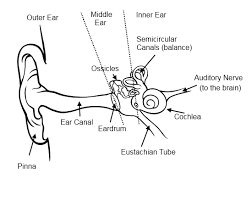 The ear consists of three basic parts - the outer
ear, the middle ear, and the inner ear. Each part of the ear serves a specific
purpose in the task of detecting and interpreting sound. The outer ear serves
to collect and channel sound to the middle ear. The middle ear serves to
transform the energy of a sound wave into the internal vibrations of the bone
structure of the middle ear and ultimately transform these vibrations into a compression
wave in the inner ear. The inner ear serves to transform the energy of a compression
wave within the inner ear fluid into nerve impulses that can be transmitted to
the brain. The outer ear consists of an earflap and an approximately
2-cm long ear canal. The earflap provides protection for the middle ear in
order to prevent damage to the eardrum. The outer ear also channels sound waves
that reach the ear through the ear canal to the eardrum of the middle ear.
Because of the length of the ear canal, it is capable of amplifying sounds with
frequencies of approximately 3000 Hz. As sound travels through the outer ear,
the sound is still in the form of a pressure wave, with an alternating pattern of high and low pressure
regions. It is not until the sound reaches the eardrum at the interface of the
outer and the middle ear that the energy of the mechanical wave becomes converted into vibrations of the inner bone
structure of the ear.
The ear consists of three basic parts - the outer
ear, the middle ear, and the inner ear. Each part of the ear serves a specific
purpose in the task of detecting and interpreting sound. The outer ear serves
to collect and channel sound to the middle ear. The middle ear serves to
transform the energy of a sound wave into the internal vibrations of the bone
structure of the middle ear and ultimately transform these vibrations into a compression
wave in the inner ear. The inner ear serves to transform the energy of a compression
wave within the inner ear fluid into nerve impulses that can be transmitted to
the brain. The outer ear consists of an earflap and an approximately
2-cm long ear canal. The earflap provides protection for the middle ear in
order to prevent damage to the eardrum. The outer ear also channels sound waves
that reach the ear through the ear canal to the eardrum of the middle ear.
Because of the length of the ear canal, it is capable of amplifying sounds with
frequencies of approximately 3000 Hz. As sound travels through the outer ear,
the sound is still in the form of a pressure wave, with an alternating pattern of high and low pressure
regions. It is not until the sound reaches the eardrum at the interface of the
outer and the middle ear that the energy of the mechanical wave becomes converted into vibrations of the inner bone
structure of the ear.
When the frequency of the compression wave
matches the natural frequency of the nerve cell, that nerve cell will resonate
with larger amplitude of vibration. This increased vibration amplitude induces
the cell to release an electrical impulse that passes along the auditory nerve
towards the brain. In a process that is not clearly understood, the brain is
capable of interpreting the qualities of the sound upon reception of these
electric nerve impulses.
No comments:
Post a Comment